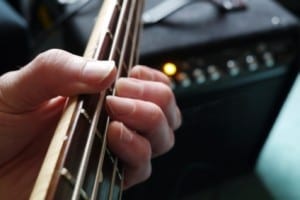Recording Electric Guitar Direct and Through an Amp
We recently wrote about the advantages and disadvantages of using your guitar rig versus your computer’s guitar rig in context of digital recording at home. When it comes down to it, neither can be described as the “best” way, as it all comes down to the sound you are looking for in your particular song. But what if you could do both without having to record two

separate guitar tracks?
There are actually at least two ways to do this. The first is called re-amping, which means taking a direct signal you’ve recorded through your computer and sending it to an amp, where you then record it again with a microphone. But today we’ll be looking at how to record both directly and through a miked amp, which tends to be an easier process for many home recording engineers.
Recording Guitar Directly and Though an Amp Simultaneously
There are a couple of ways you can split your guitar signal, with one signal going directly to your audio interface and another routed through your amp, which is then miked. However, we’ve found that one of the simplest ways to do this is by the following method.
Instead of plugging your guitar directly into your pedal setup or amp, you will instead split the signal with a DI box. One signal will go direct into your computer, and the other will go through your pedals and amp as usual, where you will then mic it and record to a second track.
Two Tracks, Same Performance
What you are left with are two completely separate tracks that feature the same performance. What you do with those two tracks will depend on what kind of sound you want.
If your miked track has a sound pretty similar to what you are looking for, you probably won’t want to do very much to it save for your typical EQ and Compression flourishes. However, the opportunities for your direct track are more varied.
The most obvious is to run the signal through an amp and effect simulator in your DAW, which will allow you to manipulate the signal in almost anyway you want. This is often used to get effects you don’t have available in your own guitar rig. But the options you have also extends to the mixing phase as well as the sound editing phase.
After your sounds are set for both tracks, one option is to blend them together. This usually means panning both tracks to the same spot and then raising the volume level of one until both sound like one track, a direct blend of the miked track and the direct track. Another method is to treat them as two completely different guitar tracks, panning them to different spots and adjusting the volume as if they were two different guitar tracks. This lets you create depth of your guitar sound, and also often results in a “bigger” sound on your track. Again, there is no correct or wrong way to adjust any of these tracks, so experiment until you get the sound you’re looking for.




